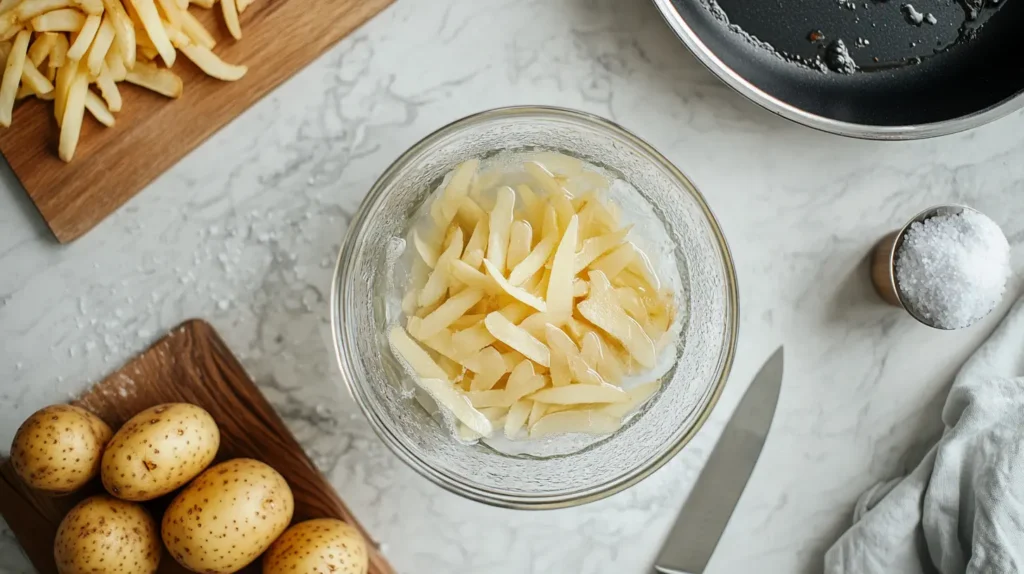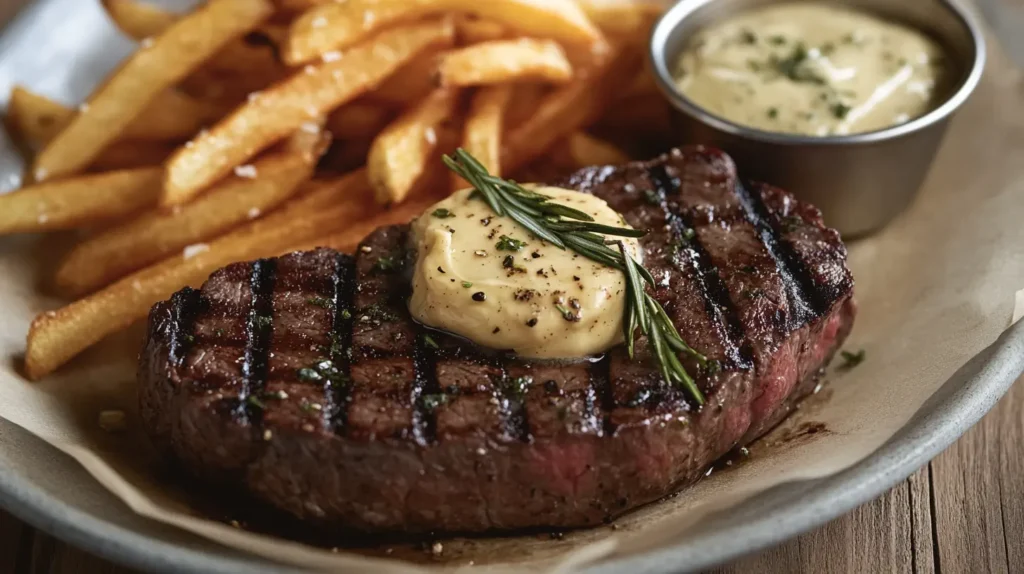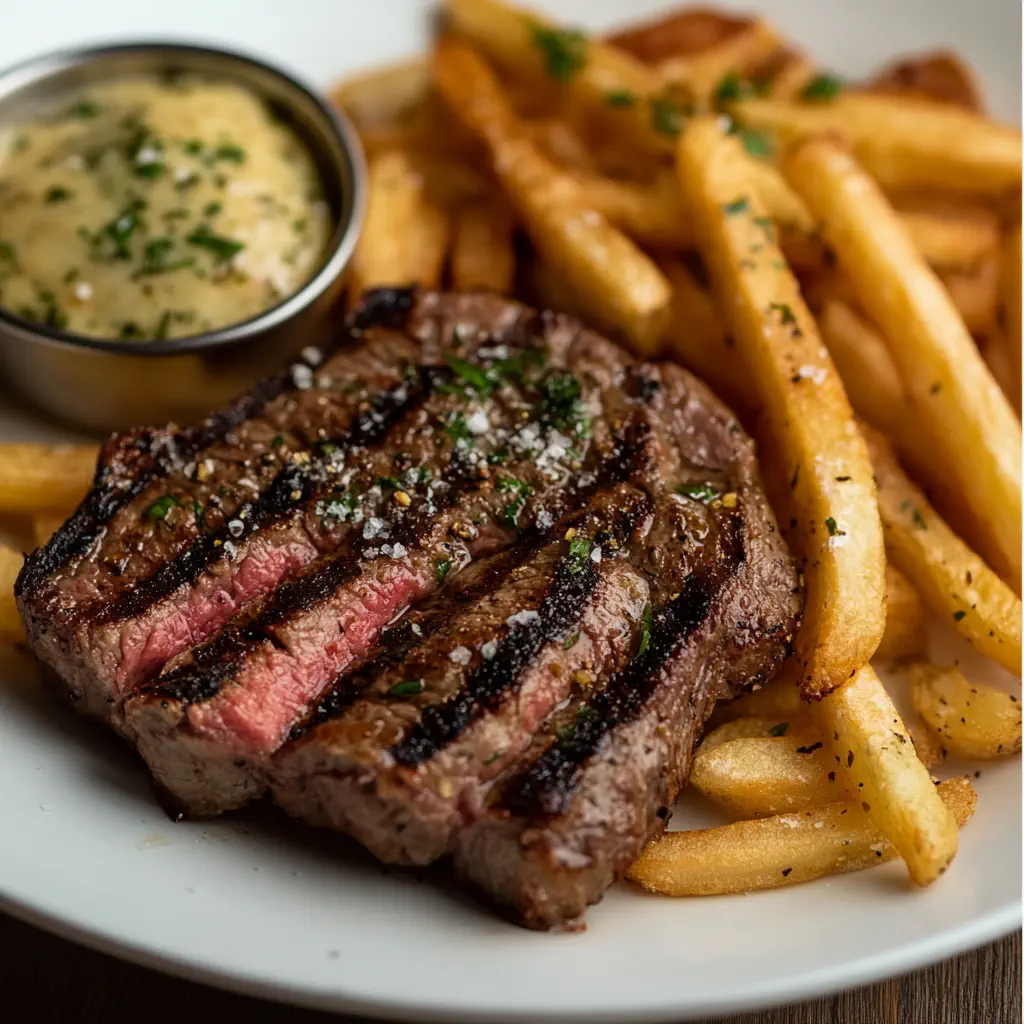Steak frites is one of the most beloved dishes in the world. It combines two simple yet incredibly satisfying elements: a juicy, tender steak and a generous serving of crispy golden fries. This classic meal has its roots in French and Belgian cuisine, but its appeal has spread far beyond Europe. Today, it’s a favorite on restaurant menus and dining tables everywhere.
What makes steak frites so special? Its simplicity. There’s no need for complicated ingredients or techniques; it’s all about choosing high-quality meat, perfectly cooked fries, and a balance of flavor. Whether you’re sitting at a fancy French bistro or enjoying it at home, steak frites offers comfort and indulgence in every bite.
Table of Contents
The History of Steak Frites
Steak frites has a rich history that starts in Europe, where both France and Belgium claim to have invented this iconic dish. The name itself translates to “steak and fries” in French, but there’s more to its story than just a simple translation. Let’s take a closer look at how steak frites became a staple in French and Belgian cuisine before taking the world by storm.
The French and Belgian Connection
The origins of steak frites are hotly debated. Many food historians believe that the dish was born in Belgium, a country famous for its fries, or as they call them, “frites.” Belgium has long been known for frying potatoes in animal fat, a cooking method that dates back to the late 17th century. These fries were often served alongside meat, which could very well have been the first version of steak frites.
On the other hand, France argues that steak frites is one of their proud culinary traditions, often linked to the rise of French bistros in the 19th century. Bistros served quick, simple, and affordable meals to workers and locals, and steak paired with fries quickly became a favorite choice. Whether Belgium or France invented it, there’s no denying that both countries played a key role in popularizing this classic dish.
The Rise of Steak Frites in Europe
By the early 20th century, steak frites had become a common feature of European dining, especially in France. It was the go-to meal for bistros, brasseries, and even roadside cafes. What made it so popular? Its simplicity. Restaurants could easily prepare the dish with just a few ingredients, and customers loved its hearty, satisfying nature.
During this time, chefs began experimenting with different ways to prepare steak, from grilling to pan-searing, and served it with various sauces such as béarnaise or peppercorn. The fries, however, were always kept crispy and golden, perfectly complementing the rich flavors of the meat.
The Global Expansion of Steak Frites
As French cuisine gained recognition around the world, so did steak frites. In the mid-20th century, the dish made its way across the Atlantic and found a home on American menus. While the French version of steak frites focused on simplicity and fresh ingredients, the American adaptation often included larger portions, thicker cuts of steak, and additional sides or sauces.
Today, steak frites can be found in restaurants everywhere, from Europe to North America, Asia, and beyond. Its popularity lies in its universal appeal – who doesn’t love a well-cooked steak and fries? Despite variations in preparation and presentation, the dish remains true to its roots as a simple yet luxurious comfort food.
Why the History of Steak Frites Matters
Understanding the history of steak frites helps us appreciate its cultural significance. This dish isn’t just a meal – it’s a reflection of European culinary traditions and the art of turning simple ingredients into something extraordinary. Whether you’re enjoying it in a Parisian café or making it at home, steak frites carries with it a sense of history and heritage that makes every bite more meaningful.
How to Make Steak Frites at Home
Making steak frites at home is easier than you might think, and the result is a restaurant-quality dish right in your own kitchen. The key is to focus on quality ingredients and follow simple techniques to bring out the best flavors in both the steak and fries. Below is a step-by-step guide, complete with measurements, to help you recreate this classic dish.
Ingredients (Serves 2)
For the steak:
- 2 boneless steaks (such as ribeye, sirloin, or filet mignon), about 8 oz (225 g) each
- 1 tbsp olive oil (15 ml)
- 2 tbsp unsalted butter (30 g)
- 2 garlic cloves, smashed
- 2 sprigs of fresh thyme or rosemary
- Salt and black pepper to taste
For the fries:
- 2 large Russet potatoes (about 1 lb or 450 g total)
- 4 cups vegetable oil (1 liter) for frying
- Salt for seasoning
Optional sauce:
- Béarnaise sauce, peppercorn sauce, or garlic butter (store-bought or homemade – optional but highly recommended)

Step-by-step perfection: Preparing golden, crispy fries is key to the best steak frites
Here’s the step-by-step process for making steak frites at home summarized in a table format for clarity and ease of use:
| Step | Details |
|---|---|
| Prepare the Potatoes for Fries | |
| Peel and slice potatoes | Peel 2 large Russet potatoes and cut them into thin strips about 1/4 inch (6 mm) thick. |
| Soak potatoes | Place the sliced potatoes in a large bowl of cold water for 30 minutes to remove starch. |
| Drain and dry | Drain the potatoes and pat them completely dry with a kitchen towel or paper towels. |
| Cook the Fries | |
| Heat the oil | Heat 4 cups (1 liter) of vegetable oil in a deep pot to 325°F (163°C). |
| First fry | Fry potatoes in small batches for 4–5 minutes until soft but not browned. Drain on paper towels. |
| Second fry | Increase oil temperature to 375°F (190°C). Fry potatoes again for 2–3 minutes until crispy. |
| Season the fries | Remove fries, drain on paper towels, and season immediately with salt. Keep warm in a low oven. |
| Prepare the Steak | |
| Bring to room temp | Remove 2 boneless steaks (8 oz each) from the fridge 30 minutes before cooking. |
| Season steaks | Rub both sides of the steaks with salt and freshly cracked black pepper. |
| Heat the pan | Heat 1 tbsp (15 ml) olive oil in a cast-iron skillet over medium-high heat until shimmering. |
| Sear the steak | Cook steaks for 3–4 minutes per side for medium-rare (adjust as needed). |
| Add butter and herbs | In the last minute, add 2 tbsp (30 g) butter, 2 garlic cloves, and thyme/rosemary. |
| Baste and finish | Tilt pan and spoon melted butter over steaks for extra flavor. |
| Rest the steak | Transfer steaks to a plate, cover with foil, and rest for 5–10 minutes. |
| Serve the Steak Frites | |
| Plate the dish | Place steak on a plate and pile crispy fries next to it. |
| Add sauce (optional) | Drizzle with pan juices or serve with béarnaise, peppercorn, or garlic butter sauce. |
| Serve immediately | Enjoy steak frites fresh and hot for the best taste and texture! |
Popular Variations of Steak Frites Around the World
Steak frites is a globally loved dish, and while its origins are firmly rooted in French and Belgian cuisine, it has inspired variations around the world. Each region adds its own twist, creating unique adaptations while staying true to the classic pairing of steak and fries. Here are some popular variations of steak frites from different parts of the globe:
French-Style Steak Frites
The French version is the classic and most well-known. The steak is typically pan-seared or grilled, often served medium-rare (“à point”) with thin, crispy fries. French bistros usually accompany the dish with a béarnaise sauce or herb-infused butter. The focus is on simplicity and quality ingredients, emphasizing the natural flavors of the meat and potatoes.
Belgian Steak Frites
In Belgium, where the dish’s roots are also celebrated, the fries—known as “frites”—take center stage. Belgian fries are traditionally fried in beef fat, giving them an extra-rich flavor. The steak is usually cooked simply, and mayonnaise is a common accompaniment for the fries. Some Belgian variations include a touch of mustard or a beer-based sauce.
American Steak and Fries
In the United States, steak frites has evolved into heartier portions with thicker steak cuts, such as New York strip or ribeye. Fries are often served in a variety of styles, including steak fries or seasoned curly fries. Sauces like barbecue, ranch, or garlic butter are common, making the dish feel more indulgent and versatile.
Argentine Steak with Fries
Argentina is famous for its high-quality beef, and steak with fries is a staple of its cuisine. Known locally as “bife con papas fritas,” this version features large, flavorful cuts of steak—often grilled over a wood fire for a smoky taste. The fries are served thicker, and chimichurri sauce (a zesty mix of parsley, garlic, and vinegar) is a must-have accompaniment.
British Steak and Chips
In the UK, the dish is more commonly referred to as “steak and chips.” The steak is usually grilled, and the “chips” are often thicker than traditional French fries, resembling what Americans call steak fries. Some pubs offer the dish with mushroom or peppercorn sauce, giving it a British twist.
Brazilian Steak and Fries
In Brazil, steak and fries are part of many family meals and casual dining menus. The dish is often served with “farofa” (toasted cassava flour) or rice as additional sides. Brazilian steakhouses, known as “churrascarias,” may also feature steak and fries as part of their all-you-can-eat offerings, often paired with garlic butter or chimichurri.
Asian-Inspired Steak Frites
In Asian cuisine, steak and fries have been reimagined with bold flavors and spices. For example:
- Japan: Wagyu beef is sometimes used for steak frites, providing an incredibly tender and buttery version of the dish. Fries may come with unique dips like wasabi mayo or soy-based sauces.
- Korea: Korean-style steak and fries might include marinated beef (bulgogi-style) paired with sweet potato fries and spicy gochujang (chili paste) dipping sauce.
Australian Steak and Fries
In Australia, steak and fries—often called “steak and chips”—are a pub classic. The steaks are usually grilled to order, and fries are served alongside. Australian versions often include sides like grilled tomatoes, fried eggs, or creamy mushroom sauce.
Latin American Carne Asada Fries
While not exactly steak frites, carne asada fries offer a creative take on the concept. Originating in Mexico and popular in the southwestern United States, this dish features thinly sliced, grilled steak served over a bed of fries, topped with melted cheese, guacamole, sour cream, and salsa.
Steak Frites with a Modern Twist
Chefs around the world have added creative modern twists to steak frites. For example:
- Truffle fries: Fries tossed in truffle oil and Parmesan cheese.
- Surf-and-turf version: Combining steak frites with seafood, such as shrimp or lobster.
- Loaded fries: Fries topped with steak bites, cheese, and sauces for a more casual, deconstructed version.

More inspiring eats you can’t miss:
- Vibrant Piped Rainbow Shortbread Cookies
- St. Patrick’s Day Brownie Trifle Dessert
- Sno Ball Brownies Recipe
- Boozy Jello Candy Melts (Without Alcohol)
- Rainbow-Filled Doughnuts recipe
FAQs About Steak Frites
What is the best steak cut for steak frites?
Popular cuts include ribeye, sirloin, filet mignon, and flank steak. Ribeye is rich and flavorful, while filet mignon is tender and buttery.
How are the fries different in steak frites?
The fries are thin, crispy, and double-fried. This method creates a crunchy exterior and fluffy interior, making them perfect for pairing with steak.
Can I use chicken or fish instead of steak?
Yes! You can substitute chicken or fish for a lighter version, but it won’t be traditional steak frites anymore.
What’s the difference between steak frites and steak au poivre?
Steak frites is served simply with fries, while steak au poivre is coated in peppercorns and served with a creamy sauce.
How do French people eat steak frites?
The steak is usually cooked medium-rare and served with thin, crispy fries, often with béarnaise sauce on the side.
Can I make steak frites with frozen fries?
Yes, frozen fries work in a pinch! Cook them as instructed and season well.
What sauces go with steak frites?
Popular options are béarnaise, peppercorn sauce, garlic butter, or red wine reduction.
Why is steak frites so popular?
Its simplicity, rich flavors, and universal appeal make it a timeless favorite worldwide.
Conclusion
Steak frites is more than just a dish—it’s a symbol of comfort, simplicity, and timeless culinary tradition. The combination of juicy, perfectly cooked steak and golden, crispy fries creates a meal that’s satisfying, elegant, and incredibly versatile. Whether you’re enjoying it at a Parisian bistro, a local restaurant, or your own dining table, steak frites never fails to impress.
The beauty of this dish lies in its simplicity. With just a few high-quality ingredients and the right cooking techniques, anyone can recreate the magic of steak frites at home. From selecting the right steak cut to mastering the art of crispy fries, it’s a meal that’s both easy to prepare and rewarding to eat.
So why not give it a try? Grab your favorite cut of steak, slice up some potatoes, and treat yourself to a classic dish that has delighted taste buds for generations. Once you take your first bite of tender steak paired with crispy fries, you’ll understand why steak frites has earned its place as a timeless favorite.
Bon appétit!

